
I have written in other features about Cassidy's major patrons Enriqueta Rylands and James Gresham, but there is another family name which crops up more than once in John Cassidy's life story, albeit in in a less spectacular way: that of George Harry Walker, his wife and children.
Information about them is not easy to find, but in this feature I do my best to uncover their lives and careers.
Elizabeth Mary Walker
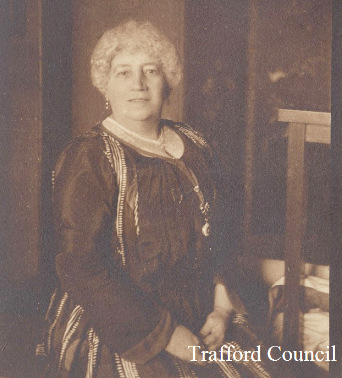
Mrs Walker, born Elizabeth Mary Collins in Salford in 1858, married George Harry Walker in 1879. They had two children, James Alan and Ottoline Mary.
She achieved some fame in the world of Persian cat breeding, as the following, from The Book of the Cat by Francis Simpson (1903) indicates:
Mrs. G. H. Walker, of Woodheys Park, is the chief supporter of the Northern Counties Cat Club, and is a member of the National Cat Club Committee. For several years she has been a well-known breeder and exhibitor of silver Persians, and has a most excellently planned cattery, which I had the pleasure of seeing when on a visit to Woodheys Grange.
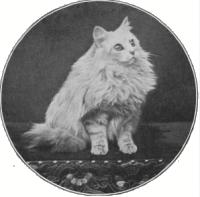 The floors of the outside catteries, which face south, are
cemented, so that they can be washed over every day. The
roofs are boarded, and then covered with galvanized iron, so
that all the rain runs away easily. The spacious apartments
are fitted with benches and ledges, and trunks of trees and
leafy shrubs are planted in the ground for the cats' special
amusement and exercise... There is a maid in attendance on
these fortunate cats, and the man who looks after the
kennels of dogs also gives a helping hand....
The floors of the outside catteries, which face south, are
cemented, so that they can be washed over every day. The
roofs are boarded, and then covered with galvanized iron, so
that all the rain runs away easily. The spacious apartments
are fitted with benches and ledges, and trunks of trees and
leafy shrubs are planted in the ground for the cats' special
amusement and exercise... There is a maid in attendance on
these fortunate cats, and the man who looks after the
kennels of dogs also gives a helping hand.... At the Northern Counties Cat Show at Manchester in 1902 Mrs. Walker exhibited a really wonderful silver kitten. I say wonderful, for this youngster, bred from the owner's 'Woodheys Fitzroy' and 'Countess', was the most unshaded and unmarked specimen of a silver I have ever seen.
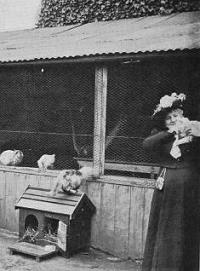
The average number of inmates of this cattery is about thirty, but at one period of Mrs. G. H. Walker's catty career the silver fever ran high, and there were sixty-three cats and kits within the precincts of the spacious and luxurious catteries of Woodheys Grange.
Elizabeth died at Woodheys Grange on 6 February 1926, leaving effects worth £3963.14.3 to her husband.
James Alan Walker
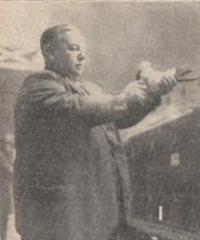
Born in 1883 in Urmston, son of George and Elizabeth, he lists himself in 1911 as Shipping Merchant and 'employer' suggesting that he became a partner in his father's firm. He lived with his parents at Woodheys Grange until 1910 when he married Glasgow-born Marion Cowan Walker and they moved into 'The Croft', on Harboro Road, not far away.
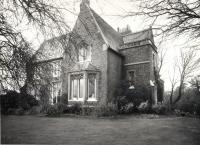
Around 1914, they moved again, to 'The Manor House', pictured above, a large Victorian mansion in Ashton-upon-Mersey, which perhaps offered more space for his pigeons. It was located close to Woodheys Grange, on the edge of what was then countryside. It is to be hoped that his pigeons never encountered the Woodheys Grange cats.
He served as President of the British Nun Club from 1928 until his death in 1944. Our picture of him, from Pigeons and Pigeon World, November 10, 1931, shows him judging Nuns at the prestigious Crystal Palace show on 17
November 1931.
They had a daughter, Alane Mary Walker, born in 1914. She is listed at the Manor House with her parents in the 1921 Census.
The 1939 register shows Alan, now retired, and Marion living in 'The Old House', Faringdon, Berkshire.
Alane was still with them, working as as elecution teacher; she never married, and lived until 1972, latterly at 47 Derbyshire Lane, Stretford.
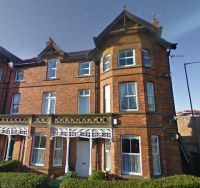
At the time of his death he was living at 2 Chubb Hill in the resort of Whitby (seen above, via Google Streetview, in 2010) on the North Yorkshire coast. His death is on record as occurring at the Bowling Green, it seems he retained his interest in sport to the last.
His widow Marion returned to Cheshire, and was living at 30 Ashton Lane, Sale when she died in 1953.
The Manor House also known as 'The Manor' had some interesting earlier residents. William Abercrombie, an early tenant, was a stockbroker, a noted patron and collector of William Morris and Dante Gabriel Rossetti, and an enthusiast for Arts and Crafts wood engraving. Of his sons born in Ashton-upon-Mersey, Patrick (1879 - 1957) became a famous architect an town planner, and Lascelles (1881 - 1938) a poet.
According to the Trafford Lifetimes archive, the house was compulsorily purchased in 1963 by the local authority who were creating a housing estate. It is commemorated by the street name Manor Avenue (formerly Carrington lane) and its public house, The Manor House.
Ottoline Mary Walker
Ottoline was born in Urmston in 1889, shortly before the family moved to Sale Bank.
Like her brother, she was able to indulge in hobbies, and learned to play the violin. She must have been of a good standard, as she played in recitals in various public halls in Manchester.

In 1913 she obtained, from London dealer J & A Beare, a violin made in 1736 by Giuseppe Guarneri del Gesù of Cremona, considered to be a maker of equal status to the more famous Stradivarius. In 2012 the same instrument is owned by the Dutch National Instruments Fund and played by Henk Rubingh, Principal Second Violin of the Royal Concertgebouw Orchestra.
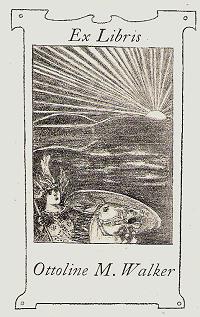
The bookplate reproduced above was found in a second-hand copy of Gilbert Cannan's translation of the first two volumes of Jean Christophe by Romain Rolland, a ten-volume novel tracing the life of a musician, for which Rolland won the Nobel Prize for Literature in 1915.
By 1921 Ottoline had moved to London, where she continued playing the violin, and made appearances on BBC radio. She lived at 7 Craven Hill Gardens, Paddington.
In 1924 she married James Forshaw, and they stayed at Craven Hill Gardens, but he disappears from the available records after 1927. Ottoline is listed as 'married' in the 1939 register but James cannot be found.
By 1930 Ottoline was living alone on a ground floor flat in 3 Pembridge Place, Kensington; later she moved to Sussex, and a house called 'Grey Thatch' in Bersted, near Bognor Regis, which she shared with a fellow musician, Harry Waldo-Warner, and his wife Rosie.
Harry was a viola player and composer, one of the founding members of the London String Quartet and a several times Cobbett Award winner for his chamber music. Rosie had been a artist's model, sitting for Whistler, Millais, Singer Sargent and many others.
Ottoline Forshaw died in Sussex on 31 August 1950.
Below Stairs
When writing of these large houses, it would be wrong to ignore the other residents, the servants, without whom the lives of the family would have been very different. The 1911 census reveals that the Walkers had five live-in servants:
Rose Bailey, age 46, Cook. Born in Yorkshire. The only one of the five who had been with the family in the 1901 census.
Jane Pierson, 38, Waitress, born in Goathland, Yorkshire.
Ruth Baker, 28, Housemaid, born in Minsterley, Shropshire.
Emily Scott, 25, Housemaid, born in Marston, Cheshire
Florence Cooper, 17, Kitchenmaid, born in Winnington, Cheshire.
Thoughts
Research of this sort can tell us little about the thoughts and feelings of the people we describe. Were they happy with their pigeons, dogs and 63 cats? What was life like as a Shipping Merchant? How did Ottoline like living alone? Did she really read that dreary tome? The solitary last few years of George Harry Walker's life, in the great rambling house, cannot have been cheerful, although his son did live nearby and he had friend on The Avenue.
Cassidy lived as a guest in the house on occasions, and in 1928, when his studio closed, he seemed to have moved in with his modelling tools. In 1930 when Mr Walker died, Cassidy resigned from the Royal Society of British Sculptors. Where his later works were created is a mystery.
Tailpiece
During our research we stumbled on this amusing 1896 newspaper snippet about some previous residents of Woodheys Grange:
At Sale, on Monday, Miss Ethel Hardwick and Miss May Hardwick, of Woodheys Grange, Ashton-on-Mersey, were summoned for riding bicycles on the footpath. The police officer said when he stopped them they admitted they were doing wrong, but thought the police would not summon ladies. (Laughter).
They were sorry the officer had to speak to them, as they were the daughters of a Magistrate. The defence was that they were not aware Moss Lane was a public footpath, but the bench imposed a fine of 5s [shillings] in each case.
It appears that the rural policeman of 1896 didn't have a busy life... The ladies' father was Richard Hardwick J.P., textile merchant, of Sparrow, Hardwick & Co, a company which survived until the 1970s, and whose ornate building at 107 Piccadilly, Manchester still exists as a hotel called 'ABode Manchester.'
Links used:
Jewish Virtual Library: Cuba for the reference to Frank Steinhardt.
Cozio stringed instrument database for Ottoline's violin
Pawpeds for Mrs Walker's Cats
Historical Directories for the street directories
Trafford Lifetimes for the house pictures
The Mapping Sculpture project for exhibition information
Ancestry.co.uk for all sorts of facts
also The Times Digital Archive, The Guardian Online, The British Newspaper Archive, and the Land Registry.
Thanks to:
Manchester Academy of Fine Arts for the photographs from their archives
Manchester and Trafford Local Studies Libraries
Dr. Minne, Archivist & Historian, Royal British Society of Sculptors (formerly the Royal Society of British Sculptors)
Ann Compton for discovering the mis-spelled 1921 record.
And especially: Richard Henderson of the British Nun Club.
Comments welcome:
info@johncassidy.org.uk
The Walker Family of Woodheys Grange
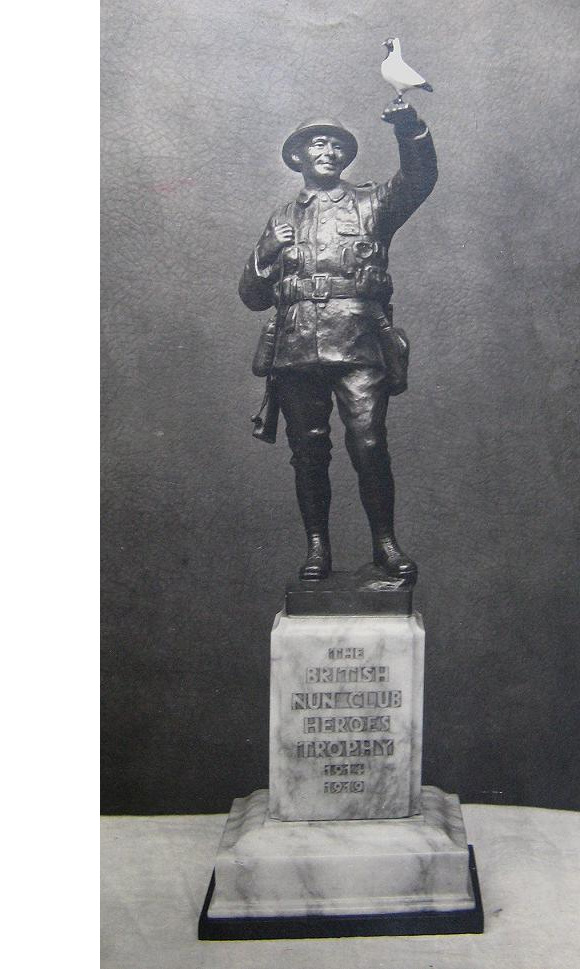
The picture above, from the archives of the Manchester Academy of Fine Arts, shows The British Nun Club Heroes Trophy, created by John Cassidy. While browsing our collection of research material, the idea came to mind to 'Google' the British Nun Club to see if anything could be found about this interesting object. Not only is the the Club still flourishing, it has a comprehensive website, including a historical section, and the Secretary, Richard Henderson, sent helpful email replies to our enquiries, including the fact that the trophy still exists, and is still presented annually.
It measures 49cm to the top of the Nun pigeon, and the alabaster base is 16cm square, and the plaques are 13.5cm by 8.5cm. It also has copper plates on the base to engrave the winners names. The figure is bronze, and the little nun pigeon is ivory. The bottom of the base of the bronze is signed by John Cassidy.The following extracts are reproduced by permission from Mr Henderson's History of the British Nun Club:
The Nun, a type of tumbler,
is a very old breed of pigeon sharing a common ancestry
with the Helmet and is mentioned in books like Treatise, and those
by Moore and Aldrovandi dating back to the 1600s. During
the mid-1800s the Nun became very popular in the UK and
shows were well supported. This culminated in the first
'Nun Club' being established in 1888, with a Mr
L.Millar of Eaton, Norwich as secretary, and the first
written Nun standard being drawn up, although it is
mentioned in the Feathered World Year Book in 1911
that 'Kirton' laid down the first Nun standard more than
100 years ago.
However by the early 1900s this club had ceased to function, although Nuns were still very popular with birds being shown at most shows. Because of this popularity and his enthusiasm for the breed, several leading Nun breeders were contacted by James Y. Baldwin from Bath, in early 1906, with the intention of forming a new club, The British Nun Club. A meeting was held in late 1906, with the first club show held the following year.
However by the early 1900s this club had ceased to function, although Nuns were still very popular with birds being shown at most shows. Because of this popularity and his enthusiasm for the breed, several leading Nun breeders were contacted by James Y. Baldwin from Bath, in early 1906, with the intention of forming a new club, The British Nun Club. A meeting was held in late 1906, with the first club show held the following year.
At the 1920 club AGM held at
the Birmingham show, it was decided to have a trophy
commissioned to commemorate those club members who died
and served during the war. With £7.12s.6d (old money) in
club funds, member J. Alan Walker stated that if this was
made up to £10.00 he would match the same. The members
present generously donated a further £14.00, therefore the
sum of £31.12s.6d was available to fund what was to be a
unique trophy. Called 'The British Nun Club Heroes Trophy
1914-1919' it is a bronze figure of a WW1 soldier mounted
on a solid marble base. The soldier has his arm
outstretched and on his fist is mounted a carved ivory
painted black Nun.
Around the time of the commission, Cassidy had created the model for a life-size war memorial which included the figure of a soldier, later commissioned by a number of towns for their memorial. He therefore had the research material already available, although the man on the trophy features a contented facial expression in contrast to that found on the large memorial figures. Pigeons were used to carry messages during the war, but the trophy does not represent such a scene, as the Nun is principally a 'show' breed and would not have been used for this purpose.
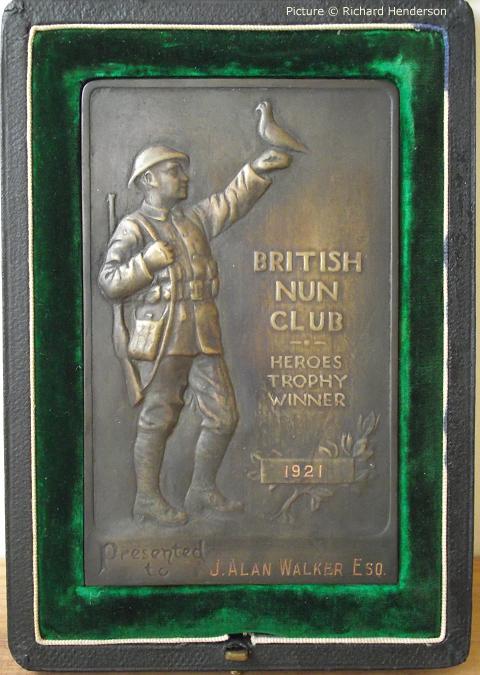
The money collected was sufficient to also commission six copies of a small bronze plaque for the winners to keep, and two of these are in the care of the Club secretary today, including the first one, presented at the December 1921 British Nun Club show which was awarded to J. Alan Walker, the major contributor to its purchase. Clearly these are also by Cassidy; they are certainly in his style.
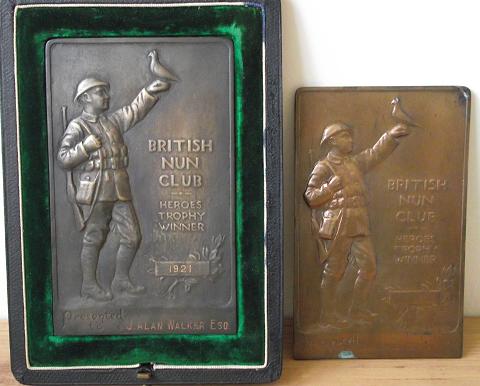
Mr Henderson mentioned that J. Alan Walker's address in Club records is 'The Manor, Ashton-upon-Mersey', a fact which threw light on a dark avenue of research into Cassidy's life and work. Census entries show that James Alan Walker was the son of George Harry Walker, a Manchester shipping merchant. We already knew that G.H. Walker commissioned and purchased other works by Cassidy, and appeared to have offered him space at his home, Woodheys Grange, on The Avenue in Ashton-upon-Mersey when the Lincoln Grove studio had to be demolished; now we can try to fill out the story.
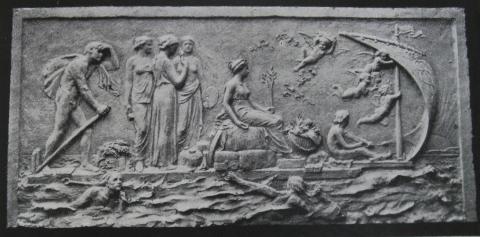
G.H. Walker owned one of Cassidy's very first works, 'Commerce' which had won a national award from the Plaisterers' Company. The plaster model was shown at the South Kensington Museum exhibition in July 1886 while Cassidy was a student. It was praised in The Times:
The peculiar treatment of
plaster in very low relief has been capitally attended to
by the successful student, John Cassidy of Manchester. His
design shows effective in the space it decorates. Upon a
raft sits Commerce. She is surrounded by produce and
attended by the Arts, three damsels in light draperies,
who stand behind her. The descriptive label tells of the
"genius of Enterprise", a seated youth who holds the
mainsheet at the prow. "Favouring winds" are indicated by
the playful little cupids who float and hover about the
sail. At the stern of the raft is a a youth steering with
a rudder; emblematical of Capital, he keeps a steady "
look out for the market."
Reportedly in the form of a bronze casting, it was exhibited at the Manchester Academy in 1910, as 'lent by G.H. Walker' and again at Cassidy's studio exhibition in 1914, described as a 'panel for a merchant's counting house' when the catalogue included the picture above.
James Alan Walker was clearly something of a sportsman, as another known Cassidy work is Golfing, Mr Alan Walker, a bronze (possibly a statuette) exhibited at the Manchester Academy in 1903.
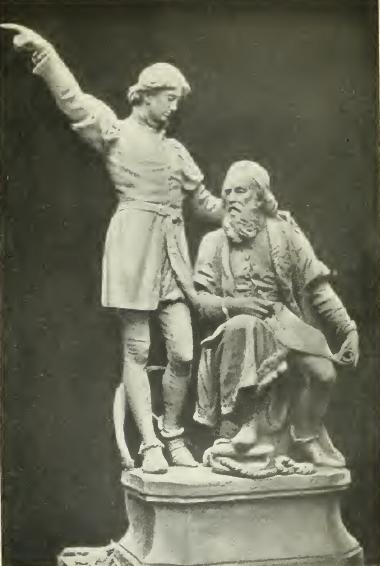
G.H Walker was also connected with John and Sebastian Cabot, a model shown at the New Gallery, London, in 1896, and the Manchester Academy, in 1898. At the exhibition of the Royal Hibernian Academy in 1899, it appeared again described as a 'model for colossal sculpture' priced at £36 15s.
Its final exhibition appearances were at the Manchester Academy Jubilee Exhibition, 1909 ('lent by G.H. Walker') and the Manchester Academy exhibition of 1910. The photograph of the model appeared in various publications connected with the 'Cabot Quadri-Centenary' celebrations on 1897, 400 years after Cabot's landing in Newfoundland, but despite critical approval it seems that the 'colossal sculpture' was never made, although statues and memorials by other sculptors can be found in Canada and in Bristol, the port from which he made his transatlantic voyages.
According to the records of the Royal Society of British Sculptors, the work was made for a series of the Pioneers of British Maritime Enterprise. The photograph was published in to an official record of some of the works by members of the RBS, entitled Modern British Sculpture, published in 1922, p. 87.
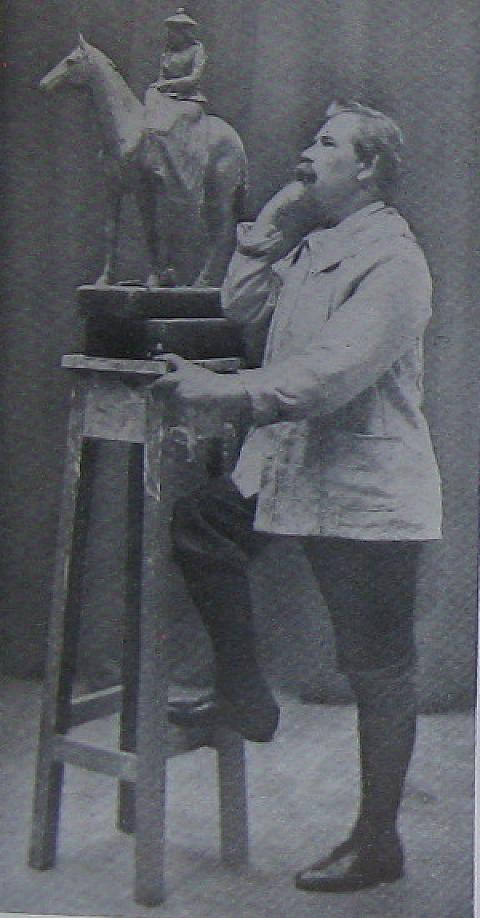
G.H. Walker also commissioned from Cassidy portraits of his wife and daughter. 'Mrs George H. Walker', a bronze statuette was exhibited at the Manchester Academy in 1901 and at Manchester City Art Gallery's Autumn Exhibition in 1904, and his daughter Ottoline Mary Walker appeared as a bronze equestrian statuette. The photograph above, apparently taken in the Lincoln Grove studio, appeared in the May 1903 issue of the magazine Faces and Places, as part of an article about Cassidy, and the work itself was exhibited at Manchester Art Gallery's Twenty-Sixth Autumn Exhibition, 1908 as 'On the Moorland - Ottoline Mary, Daughter of George H. Walker, Esq.'
Of all the works described above, the Nun Club trophy and plaques are the only ones, as far as we have yet determined, which still exist. If any relations of the Walkers , or indeed anyone else, know the location of the others, we'd be very pleased to hear from them. George and Marion's direct line ended with the death of Alane in 1972, which makes the survival of the Cassidy works unlikely.
George Harry Walker - his life and work
(Note: he appears as 'George Henry Walker' in some documents, but it appears that he preferred 'Harry' - it appears thus in his own writing on the 1911 census form.)
The nineteenth century saw the development in Manchester city centre of shipping warehouses, which specialised in the packing and distribution of the cotton products manufactured in the outskirts of the city and its surrounding towns. George Harry Walker was born in 1856 in Manchester. His father has been a 'packer' in one of these warehouses, and his son followed in his father's trade became a 'buyer' and then an employer in his own right. A 'Directory of Shipping Merchants in Manchester and Salford from 1886 lists over 500 such companies. Not yet on that list at that time was Steinhardt, Walker & Co.

However an 1895 directory (above) lists Steinhardt, Walker & Co. at 66 Faulkner Street, today in the heart of Manchester's Chinatown.

In 1909, the firm moved into 'Canada House' at 3 Chepstow Street, a large new block which was built for shared occupation by many merchants, and featured technical advances including hydraulic presses in the basement to compress the products into bales - these were powered by the network of hydraulic pipes around the city centre supplied from Manchester Corporation's pumping stations. The building survives, in use as offices, and traces of its former use can be seen.
The connections of the shipping merchants with remote countries sometimes led to their assuming an additional roles as Consul - representatives of a foreign government - in Manchester, and directories of the time list Mr Walker as Consul for Cuba.
The identity of 'Steinhardt'
is not confirmed but I believe it was Frank Maximilian
Steinhardt (1864 – 1938), born to a Jewish family in
Munich, who emigrated to the United States, enlisted in
the army, and was a sergeant during the war in which the
U.S. occupied Cuba. He became a successful businessman,
served as U.S. consul general in Havana (1902–07), and the
owner of the Electric Railway Company in Havana.
Another Cassidy patron, Enriqueta Rylands, was born in Havana, Cuba where her father was a sugar merchant, but this may well be coincidence, as may be the fact that James Gresham, engineer, art lover and Cassidy supporter, was a neighbour of the Walkers on The Avenue.

Above is a directory entry for 1909 recording Mr Walker as Consul, and his home address at 'Woodheys Grange', Ashton-on-Mersey, which was later to figure in Cassidy's career. This was their second home in the area: in 1891 they lived at 'Sale Bank', in the town of Sale, having moved from Urmston. Their two children were born in Urmston while George was still an employed 'buyer.' Mr Walker was a very early adopter of the telephone, appearing in the 1896 directory. He appears to have lived a quiet life, with no ambition to public office or great philanthropy.
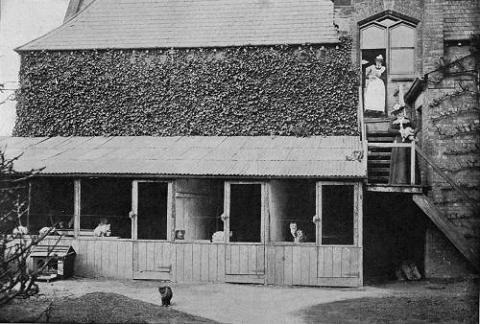
In 1928, Cassidy's studio in Lincoln Grove, Manchester was requisitioned for the building of a sliced-bread bakery, and he had to move out. It appears that George Harry Walker came to his rescue with the offer of work space at his mansion, Woodheys Grange, on 'The Avenue' in Ashton-upon-Mersey, Cheshire, a few miles away from Manchester. Cassidy was already a friend of the family: the 1921 Census shows Cassidy (classed as a 'visitor') living alone in the house except for the Walkers' cook Rose Bailey. George and Elizabeth were staying with Ottoline in her London house; who was looking after the cats is not recorded.
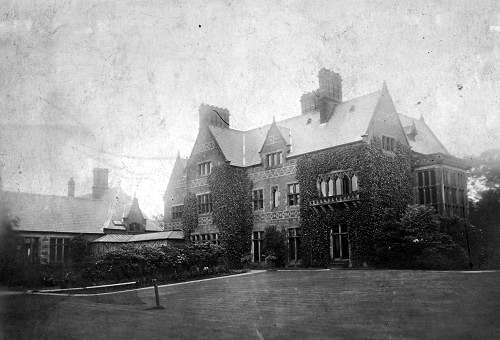
Above, Woodheys Grange seen from the garden. 'The Avenue', known earlier as Brooks's Avenue, was created for William Cunliffe Brooks, a lawyer and banker who had inherited large tracts of farmland in the area which had been bought by his father Samuel Brooks. It would seem that this, and the nearby Manor House, which were built c. 1870 for William Brooks, for rental to encourage people to live on The Avenue, their newly-opened road. William Cunliffe Brooks, who served as Member of Parliament for constituencies in the area for many years, died in 1900; in July 1919, Woodheys Grange was included in an auction of land and buildings in the Avenue area held in Manchester, and G.H. Walker bought it and its grounds for £2000; a similar figure was paid for The Manor House.
John Cassidy gave Woodheys Grange as his business address after 1928, and carried out a few small commissions there, but his tenure was short-lived. G.H. Walker, whose wife had died a few years earlier, died on 28 July 1930, while staying at 'The Beacon', Goathland, North Yorkshire. Woodheys Grange and its adjoining land were sold, and by 1932 the house had been demolished. Smaller houses and new streets appeared on the adjoining land, but for some reason (legal complications of some kind?) the site of the house, its gardens and its little piece of woodland was left empty for many years. Finally, it was bought by the Methodist Church which was planning to close two other churches in Sale - Wesley and Barkers Lane - and combine their congregations in a modern building. The new church, The Avenue Methodist Church, was officially opened by Dr Marjorie Lonsdale on 28 September 1963. In more recent times a Living Well Centre has been added.
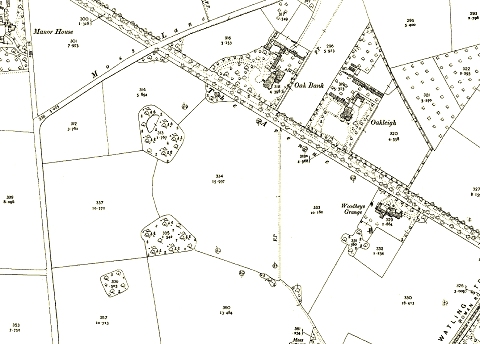
The Avenue, Ashton-upon-Mersey, circa 1910. For a fuller story of this curious street and its inhabitants, see our earlier feature Woodheys Grange and The Avenue.
As for Steinhardt, Walker & Co., by 1920 the name Steinhardt had vanished, and the firm had become G. & A. Walker, George's son James Alan Walker preferring his second name. They remained in business at Canada House though the hard trading times of the 20s and early 30s. Alan Walker carried on after his father's death in 1930, the firm appearing in the Telephone Directory for 1935. In 1937 Alan Walker registered a Deed of Arrangement, assigning his property to a trustee for the benefit of his creditors.
As the twentieth century progressed, many countries had developed cotton industries of their own, Japanese industry offered competition in the export trade, and Manchester's merchants were dependent on the Lancashire manufacturing firms which, according to some historians, suffered from poor management. By the 1950s, the once-flourishing trade of Shipping Merchant was more or less extinct, but many of the warehouses, architect-designed to impress, found new lives as offices, apartments and hotels, and are still a feature of the city centre today.
Is it Becoming to Ride Astride?
While compiling this piece I stumbled on a feature from the magazine The Sketch of November 21 1906 with the above title. The etiquette of the Victorian era required ladies to ride a horse 'side-saddle' with both legs on the same site of the horse, but the authors soggest that it was becoming common for ladies to ride with their legs astride the horse in the 'old Elizabethan style' as men has always done. Apparently, 'Doctors differ as to the wisdom of the fashion, but there are many that recommend it.'
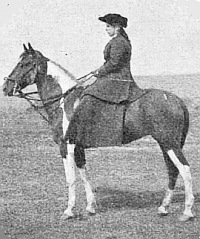 In
evidence, pictures are provided of seven 'well-known' ladies
happily astride. The Duchess of Westminster, Lady
Castlereagh, Lady Constance Stewart-Richardson, Lady
Rosemary Leveson-Gower daughter of the Duchess of
Sutherland, Miss Child, Miss Gresham of Oak Bank, Old
Trafford, and Miss Ottoline Walker of Ashton-on- the-Mersey.
In
evidence, pictures are provided of seven 'well-known' ladies
happily astride. The Duchess of Westminster, Lady
Castlereagh, Lady Constance Stewart-Richardson, Lady
Rosemary Leveson-Gower daughter of the Duchess of
Sutherland, Miss Child, Miss Gresham of Oak Bank, Old
Trafford, and Miss Ottoline Walker of Ashton-on- the-Mersey.'Miss Gresham' was Millie, daughter of James Gresham, another Cassidy supporter. How did she and her friend Ottoline come to be mixing with the aristocracy? The picture of Ottoline is reproduced here. Interestingly, Cassidy's sculpture (shown above) shows her riding side-saddle, but that was made in 1901.
Written by Charlie Hulme, October 2012. Updated May 2023.